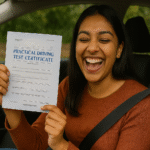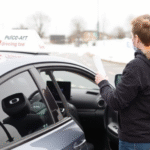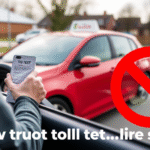Assessing the Difficulty: Is the Practical Driving Test Hard?
Preparing for a practical driving test can often stir up a whirlwind of emotions. Many learners wonder, “Is the practical driving test hard?” This question can evoke anxiety, excitement, and sometimes doubt. Understanding what makes the test challenging helps you approach it with the right mindset. Let’s break down the factors involved in the practical driving test and assess its difficulty.
Understanding the Practical Driving Test
The practical driving test assesses your ability to safely operate a motor vehicle and follow traffic laws. It typically lasts around 30 to 40 minutes and evaluates numerous aspects, including:
- Basic vehicle control
- Adherence to road signs
- Proper signaling
- Parking techniques
- Safe driving in various conditions
During the test, your instructor will observe your maneuvers, decision-making, and confidence behind the wheel. Each criterion is scored, and you need to achieve a satisfactory level to pass.
What Makes the Test Difficult?
Several factors contribute to how hard the practical driving test can feel:
1. Nerves and Pressure
Feeling nervous on the day of the test is common. The pressure of being evaluated can affect your performance. Many candidates find they make small mistakes when anxious, leading to challenges during the test. Practicing methods for calming nerves, such as deep breathing, can help enhance your experience.
2. Preparation and Practice
Your level of preparation plays a crucial role. Those who take the time to practice consistently often feel more confident. Consider these strategies to ensure you’re well-prepared:
- Take driving lessons from a certified instructor
- Practice different driving conditions such as night driving or bad weather
- Rehearse specific maneuvers like parallel parking and three-point turns
3. Road Conditions
The driving test evaluates your ability to navigate real road conditions. Some tests may take place in heavy traffic or complex environments, which can challenge even experienced drivers. Familiarizing yourself with the testing area beforehand can reduce surprises and help you feel prepared.
4. Understanding the Scoring System
Each test has a specific scoring system that assesses your performance. It’s essential to be familiar with the points deducted for various mistakes, such as:
| Mistake | Points Deducted |
|---|---|
| Failing to signal | 3 |
| Not checking mirrors | 4 |
| Improper lane changes | 4 |
| Speeding | 5 |
By understanding these evaluations, you can focus on areas that might require more attention during your practice sessions.
Strategies to Overcome Test Difficulties
Regardless of how hard you find the test, implementing effective strategies can make a significant difference:
- Practice regularly: Frequent practice helps you gain experience and build confidence.
- Mock tests: Take mock driving tests with an experienced driver to simulate the actual experience.
- Stay informed: Understand local traffic laws and road signs to ensure you’re knowledgeable on the test day.
- Stay positive: Maintain a positive mindset. Remind yourself that you have prepared for this moment.
The Average Pass Rate
Understanding the statistics around passing the practical driving test can provide perspective. The average pass rate varies from country to country and between regions, but it typically falls between 40% to 60%. This indicates that while many people do pass, a significant number do not, highlighting the importance of thorough preparation.
As you prepare for your practical driving test, keep in mind that every learner has a unique experience. What feels hard for one person may be easier for another. Focus on your individual skills and development, and remember, the goal is to demonstrate your ability to drive safely.
Ultimately, is the practical driving test hard? For some, it might be challenging, but with the right preparation and mindset, passing is definitely achievable. Good luck!
Common Mistakes That Lead to Failure in Driving Tests
Many aspiring drivers feel anxious when preparing for their driving tests. Understanding the common mistakes that lead to failure can help you avoid unnecessary stress and increase your chances of passing. Here are some key issues that often contribute to unsuccessful attempts during the driving test.
1. Lack of Preparation
One of the most significant mistakes is not preparing adequately. Failing to practice enough can lead to feeling overwhelmed during the test. Here are a few ways to ensure you’re prepared:
- Practice regularly behind the wheel.
- Take a few lessons with a qualified instructor.
- Familiarize yourself with the test route.
Investing time in practice can boost your confidence and skill level when it matters most.
2. Not Understanding the Test Requirements
Each driving test has specific requirements that must be met. Failing to understand what examiners look for can lead to mistakes that could easily be avoided. Be sure to:
- Review the driving manual specific to your region.
- Understand the scoring system used by the examiner.
- Ask your instructor any questions you have about the test.
Know what to expect, and you’ll feel more in control.
3. Poor Vehicle Control
Demonstrating excellent vehicle control is essential. Many candidates fail the test because they struggle with basic control aspects. Focus on:
- Keeping a steady hand on the wheel.
- Maintaining appropriate speed.
- Using turn signals effectively.
Practicing these skills will not only increase your chances of passing but also make you a safer driver.
4. Ignoring Road Signs and Signals
Paying close attention to road signs and signals is critical. Not adhering to these can result in immediate failure. To avoid this mistake:
- Study the meanings of common road signs.
- Practice stopping at stop signs and obeying traffic lights.
- Learn the rules regarding yielding and right of way.
Being vigilant about these rules can help you navigate the test smoothly.
5. Not Managing Nervousness
It’s normal to feel nervous on the day of the test, but letting anxiety take over can lead to poor performance. Here are tips to keep your nerves in check:
- Arrive early to avoid unnecessary stress.
- Take deep breaths to calm yourself before starting.
- Visualize a successful test beforehand.
Managing your emotions can make a significant difference in your driving performance.
6. Inadequate Knowledge of Parking Skills
Parking is a crucial part of the driving test, and failing at this skill can cost you the exam. To improve your parking ability, make sure to:
- Practice parallel parking multiple times.
- Learn how to park in various situations, such as angled or perpendicular parking.
- Be aware of your vehicle’s dimensions to judge space accurately.
Mastering parking techniques can be the key to a passing score.
7. Disregarding Test Day Guidelines
Many candidates fail because they don’t follow essential test day guidelines. Missing documents or not adhering to rules can lead to immediate failure. Key components to remember include:
- Bringing necessary identification and paperwork.
- Arriving in a safe and working vehicle.
- Being aware of the dress code or any regulations set by the testing agency.
Staying organized and informed will help you avoid pitfalls on the big day.
8. Overconfidence
While confidence is vital, overconfidence can lead to errors. Some applicants believe they can skip critical checks or drive carelessly. To ensure you remain grounded:
- Continuously practice and learn, even if you feel ready.
- Be humble and open to feedback from instructors.
- Focus on each part of the test, rather than just finishing it quickly.
Balancing confidence with caution can give you the upper hand during your driving test.
By understanding and avoiding these common mistakes, you will increase your chances of success in your driving test and promote safer driving habits in the long run. Remember, preparation and awareness are key elements to achieving your driving goals.
Tips for Overcoming Test Anxiety on Your Driving Exam
Feeling anxious before your driving exam is completely normal. Many people experience test anxiety, which can sometimes prevent them from performing their best. Here are some practical tips to help you overcome that anxiety and boost your confidence on the day of your driving test.
Understand Your Anxiety
First, it’s important to recognize that some level of nervousness is common. Understand what parts of the test make you the most anxious. Is it the driving itself, the examiner watching you, or fear of failing? Acknowledging these feelings is the first step towards managing them.
Practice, Practice, Practice
This might seem obvious, but the more you practice, the more comfortable you’ll feel. Here are some effective strategies:
- Take Mock Tests: Simulate the driving test conditions with a friend or instructor. This can help reduce the fear of the unknown.
- Focus on Weak Areas: Identify what you struggle with, whether it’s parallel parking or highway merging, and practice these specific skills until you feel confident.
- Driving Lessons: Consider investing in a few additional driving lessons. Professional instructors can provide valuable tips and insights that might ease your anxiety.
Use Relaxation Techniques
Relaxation strategies can help calm your nerves and improve your focus. Here are several techniques to try:
- Deep Breathing: Take slow, deep breaths in through your nose and out through your mouth. This can help slow your heart rate and reduce feelings of panic.
- Visualization: Picture yourself successfully completing the driving test. Visualizing success can create a positive mindset and reduce anxiety.
- Mindfulness: Practice staying present. When you’re driving, focus on the task at hand, rather than worrying about the outcome.
Prepare for the Day
On the day of the test, being well-prepared can make a significant difference in your anxiety levels. Here’s how to prepare:
- Get Plenty of Rest: A well-rested mind is more focused and less prone to anxiety.
- Eat a Light Meal: Have a nutritious breakfast or snack before your exam. Avoid heavy or greasy foods that might make you feel sluggish.
- Arrive Early: Getting to the testing site early gives you plenty of time to settle in and get comfortable with your surroundings.
Stay Positive
Maintaining a positive attitude can greatly influence your performance. Here are some tips to establish a positive mindset:
- Affirmations: Use positive affirmations like “I am a confident driver,” or “I am prepared for this test.” Repeating these statements can help shift your thoughts.
- Shift Your Perspective: Rather than focusing on the fear of failure, think of this as an opportunity to demonstrate your skills.
- Talk About It: Share your feelings with friends or family who can offer encouragement and support. They can remind you of your practice and successes.
After the Test
Regardless of the outcome, it’s vital to reflect positively on your experience. If you pass, congratulations! You’ve worked hard to get there. If you don’t, remember that failure is not the end. Many successful drivers didn’t pass their tests on the first attempt. Use the experience to improve and prepare for your next opportunity.
The key to overcoming test anxiety lies in preparation and mindset. By understanding your fears, practicing effectively, and employing relaxation techniques, you can navigate your driving test with greater ease. Remember, you are not alone in feeling anxious, and with the right approach, you can turn that anxiety into confidence. Good luck!
The Role of Practice: Preparing Effectively for Your Driving Test
Preparing for your driving test can feel overwhelming, especially if you wonder whether the practical driving test is hard or not. However, with the right preparation and practice, you can increase your chances of passing with confidence. Understanding the mechanics of driving and knowing what to expect on test day are crucial steps toward success.
First, let’s break down the essential components of the practical driving test. Typically, the test includes:
- Vehicle control: Demonstrating your ability to operate the vehicle effectively.
- Traffic laws: Knowledge and adherence to road rules.
- Safe driving: Performing maneuvers safely to avoid accidents.
- Observation: Staying aware of your surroundings while driving.
The more prepared you are in these areas, the less daunting the test will seem. One effective way to accomplish this is through consistent practice. Here are some practical steps you can take to prepare effectively for your driving test:
Establish a Routine
Creating a driving schedule can help reinforce your learning. Consider driving several times a week and varying your practice routes. Different environments provide unique challenges, such as heavy traffic, roundabouts, and parking situations. Familiarity with diverse driving conditions will enhance your skills.
Focus on Maneuvers
Your test will likely include specific maneuvers such as:
- Parallel parking
- Three-point turns
- Stop signs and traffic signals
- Turning left and right
Practice each maneuver repeatedly until you feel comfortable. You might even want to simulate test conditions by performing these in a quiet area without distractions.
Utilize Mock Tests
Mock tests are a fantastic way to prepare. Have a licensed driver act as an examiner and follow your local driving test criteria as closely as possible. This practice can help you acclimate to the testing environment and provide valuable feedback on areas for improvement.
Learn From Feedback
After each practice session, take time to reflect on your performance. Were there any mistakes you made? If you’re driving with an instructor or an experienced driver, ask them for their opinion. Understanding your weaknesses can allow you to focus your efforts where needed.
Know the Test Format
Being familiar with what to expect can significantly reduce anxiety on test day. Generally, a practical driving test lasts around 30 to 40 minutes. You’ll begin with an introduction to the examiner, and they’ll explain the test components.
| Test Component | Duration | Description |
|---|---|---|
| Vehicle Safety Checks | 5 minutes | Basic checks on lights, signals, brakes, etc. |
| Real Driving | 30 minutes | Driving in various traffic situations. |
| Feedback Session | 5 minutes | Examiner’s notes on your performance. |
Understanding this timing can help you manage your nerves. Being organized can make you feel more in control throughout the process.
Relax and Stay Positive
Your mindset plays a significant role in your performance. The practical driving test can feel daunting, but staying calm and maintaining a positive attitude can improve your focus. Practice relaxation techniques such as deep breathing before the test.
Remember, preparation is key. The more you practice, the more confident you will feel on the day of your driving test. It’s natural to feel anxious, but a well-prepared driver is more likely to succeed. By investing time and effort into your practice, you’ll not only answer the question of whether the practical driving test is hard but will also find it becoming a manageable challenge on your journey to becoming a licensed driver.
Understanding the Scoring System of the Practical Driving Test
When preparing for your practical driving test, it is essential to understand how the scoring system works. This knowledge can significantly impact your performance and help you manage your expectations. The practical driving test assesses your ability to operate a vehicle safely and responsibly in various driving situations. Knowing how the scoring system operates can help you focus on what truly matters during the test.
The practical driving test is typically broken down into several categories. Here’s an overview of what you can expect:
- Vehicle Control: Your ability to control the vehicle is critical. This encompasses steering, braking, and accelerating smoothly.
- Observations: You must demonstrate proper observation skills, such as checking mirrors, signaling, and being aware of other road users.
- Compliance with Traffic Rules: Following traffic signs, signals, and road markings is crucial for your score.
- Safety Maneuvers: This includes executing maneuvers such as parking, turning, and performing emergency stops.
- Positioning: Maintaining the correct lane position while driving is essential for safety and score.
During the test, you will also be evaluated on your overall behavior while driving. This includes maintaining a calm demeanor and making safe decisions on the road. Each part of the test has a specific scoring method, which typically ranges from a maximum score to points deducted for errors.
The scoring for the practical driving test typically focuses on critical errors, minor errors, and serious faults. Here are the details:
| Type of Error | Description | Points Deducted |
|---|---|---|
| Critical Error | Endangers the safety of yourself or others, e.g., running a red light. | Immediate failure |
| Serious Fault | Significant mistake that could lead to danger, e.g., not checking blind spots. | Major point deduction |
| Minor Error | Less critical mistakes, e.g., slight steering adjustments. | Few points deducted |
To pass the driving test, you need to avoid accumulating too many critical or serious faults. It’s advisable to practice regularly in various driving conditions. Focus on each category evaluated in the test to improve your scoring potential. Remember that confidence plays a vital role. By familiarizing yourself with the scoring system, you reduce anxiety when taking the test.
One common misconception is that the test is designed to trap you or catch you out. In reality, it’s more about showcasing your ability to drive safely and responsively. Instructors are looking for good practices and safe driving habits. Therefore, understanding the scoring system can help shape your driving skills positively, leading to better performance.
It is also important to prepare for the unexpected. Conditions during the actual driving test can differ from what you practiced. For instance, you may encounter pedestrians or cyclists, and your ability to react appropriately is crucial. Always keep a safe distance, and remember to use your mirrors frequently.
Another helpful tip is to review your practice sessions. Ask your instructor to provide feedback on your performance. Knowing where you excel and where you need improvement can guide your preparation effectively. Keep track of your minor errors and work towards minimizing them.
Do not underestimate the importance of mental preparedness. Arrive at the test location early, and take a moment to gather your thoughts. Stay calm and focused. Confidence can have a dramatic effect on your driving capabilities and your score. By understanding the scoring system for the practical driving test and preparing accordingly, you will be better positioned to succeed and earn your driving license.
Key Takeaway:
When considering whether the practical driving test is hard, it’s essential to assess it from multiple angles. First, the difficulty of the test can vary based on individual experiences and preparedness. Many find the exam challenging due to nerves or anxiety, especially in high-pressure situations. Understanding that this is a common feeling can be reassuring.
Common mistakes during the driving test often lead to failure. These errors can range from minor issues like forgetting to signal, to more significant ones like failing to check mirrors adequately. Recognizing these pitfalls is crucial for success. By actively working to avoid them during practice, you foster a deeper understanding of safe driving and the expectations of the examiners.
Anxiety is another critical factor that can make the practical driving test feel more difficult than it truly is. It’s normal to feel nervous, but there are several strategies to manage test anxiety effectively. Techniques such as deep breathing exercises, positive visualization, and familiarization with the test route can significantly calm your nerves and boost your confidence.
The role of practice cannot be understated when it comes to preparation. Hours spent behind the wheel, preferably with a qualified instructor, can make all the difference. Practice helps you become comfortable with different driving situations, enhances your reflexes, and solidifies your driving skills, leading to a more positive testing experience.
Understanding the scoring system of the practical driving test is vital. Knowing what evaluators look for, such as control of the vehicle, road awareness, and compliance with traffic rules, helps you focus your practice sessions on areas that matter most. This clarity can lead to more thoughtful preparation and a better chance of passing.
While the practical driving test may seem hard at first, success is attainable with the right mindset, thorough preparation, and practice. By learning from common mistakes, managing anxiety, and understanding the test requirements, you can turn what seems like a daunting challenge into an achievable goal.
Conclusion
Successfully passing your practical driving test is a significant milestone that unlocks the independence and freedom of being a licensed driver. Assessing whether the practical driving test is hard often depends on your preparation, mindset, and understanding of the test’s components. By recognizing common mistakes that can lead to failure, such as forgetting check signals or misjudging speeds, you can proactively work on avoiding these pitfalls.
Overcoming test anxiety is another crucial factor in ensuring you perform your best on exam day. Techniques like deep breathing and positive visualization can significantly improve your confidence. Remember, it’s normal to feel nervous, but managing that anxiety can set you up for success.
Effective preparation is key; practicing with a qualified instructor or experienced driver can enhance your skills and knowledge. Familiarizing yourself with the car you’ll be driving and the routes you may take can further boost your readiness. Understanding the scoring system of the practical driving test gives you insight into what examiners are looking for, allowing you to focus on specific areas that could make a difference in your score.
All these elements—assessment of difficulty, common pitfalls, anxiety management, effective practice, and scoring comprehension—play a critical role in shaping your driving test journey. With the right mindset and preparation strategies, you can face your practical driving test with confidence, turning it from a daunting challenge into an achievable goal. Embrace the process, learn from your experiences, and you just might discover that the test isn’t as hard as it seems.







Leave a Reply